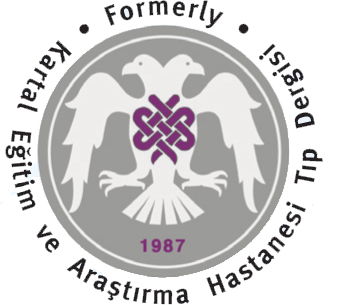ISSN : 2587-0998
Desfluran ya da Sevofluran Anestezisinden Sonra Erken Ameliyat Sonrası Derlenmenin Karşılaştırılması
Özlem Sezen, Elif BombacıKartal Dr. Lütfi Kırdar Eğitim Ve Araştırma Hastanesi Anesteziyoloji Ve Reanimasyon Kliniği, İstanbulGİRİŞ ve AMAÇ: Bu çalışmanın amacı, genel anestezi altında alt karın cerrahisi geçirecek olan hastalarda sevofluran ve desfluran kullanımının ameliyat sonrası erken dönem etkilerinin karşılaştırılmasıdır.
YÖNTEM ve GEREÇLER: Elektif alt batın cerrahisi geçirecek 18-75 yaş arası ASA fizik durumu I ya da II olan 80 hasta seçilerek iki gruba ayrıldı. Anestezi indüksiyonundan önce kalp hızı, kan basıncı, periferik oksijen satürasyonu ölçüldü ve nöromusküler monitörizasyon uygulandı.Tiyopental 5-7 mgr/kg ve fentanil 1 µgr/kg iv uygulanmasının ardından rokuronyum 0.6 mg/kg iv uygulanarak endotrakeal entübasyon gerçekleştirildi. Anestezi idamesi Grup Ide %4 desfluran Grup IIde %3 sevofluran %50 oksijen-hava karışımı ile sağlandı. Cerrahi sırasında hemodinamik değişikliklere göre fentanil 1 µgr ve volatil anesteziklerin konsantrasyonları değiştirilerek uygulandı. Cerrahinin sonunda volatil anestezikler kesilerek bütün hastalara %100 oksijen solutuldu. TOF %85 değerine ulaşınca hastalar ekstübe edildi ve yüz maskesi ile oksijen verildi. Peroperatif aksiller ısı, SpO2,hemoglobin (Hb), arteriyel basınç, kalp hızı ve total opioid tüketimi kaydedildi. Postoperatif dönemde 1., 5., 10., 15., 20., 30., 45., 60. dakikalarda SpO2 değerleri, havayolu kontrol ve modifiye Aldrete derlenme skorları kaydedildi. Ağrı değerlendirilmesi vizüel analog skala (VAS) ile 1-10 arası olacak şekilde aynı zaman aralıklarında değerlendirildi.
BULGULAR: Gruplar arasında tanımlayıcı değerler, anestezi süreleri, cerrahi süreleri, ekstübasyon süreleri, aksiller ısı, ameliyat öncesi SpO2, ameliyat öncesi ve sonrası hemodinamik değerler havayolu kontrol skoru ve VAS değerleri arasında anlamlı fark tespit edilmedi. Grup Ide toplam opioid dozunun anlamlı olarak daha yüksek, ameliyat öncesi Hb ve ameliyat sonrası Hb değerlerinin ise anlamlı olarak daha düşük olduğu gözlendi (p<0.01).
TARTIŞMA ve SONUÇ: Genel anestezi uygulamalarında desfluranın özellikle ameliyat sonrası komplikasyon riski yüksek olan hastalarda sevoflurana tercih edilebilir.
Anahtar Kelimeler: Ameliyat sonrası, derlenme; desfluran, sevofluran.
Comparison of Early Postoperative Recovery after Desflurane or Sevoflurane Anesthesia
Özlem Sezen, Elif BombacıDepartment of Anesthesiology and Reanimation, University of Health Sciences, Kartal Dr. Lütfi Kırdar Training and Research Hospital, İstanbul, TurkeyINTRODUCTION: The aim of this study was to compare the early postoperative recovery effects between patients who were given sevoflurane or desflurane before having lower abdominal surgery under general anesthesia.
METHODS: Eighty patients aged between 18 and 75 years with an American Society of Anesthesiologists physical status classification of I or II who were scheduled for elective lower abdominal surgery were divided into 2 groups. Before the induction of anesthesia, heart rate (HR), blood pressure, and peripheral oxygen saturation (SpO2) were measured, and neuromuscular monitoring was performed. Following the intravenous (IV) administration of 5 to 7 mg/kg thiopental and 1 mcg/kg fentanyl, 0.6 mg/kg rocuronium was used to facilitate endotracheal intubation. Maintenance of anesthesia was provided using 4% desflurane in Group I and 1.3% sevoflurane in Group II in a 50% oxygen-air mixture. During surgery, additional doses of 1 mcg/kg fentanyl were administered and the concentration of volatile anesthetics was adapted according to hemodynamic conditions. At the end of the operation, volatile agents were discontinued and 100% oxygen was administered to all patients. When the train-of-four stimulation value exceeded 85%, the patients were extubated and oxygen was provided via facemask. Perioperative axillary temperature, SpO2, hemoglobin (Hb), arterial pressure, HR, and total opioid consumption were recorded. SpO2 level, airway control value and modified Aldrete score were recorded at the 1st, 5th, 10th, 15th, 20th, 30th, 45th, and 60th minutes during the postoperative period. Pain evaluation was performed using a visual analog scale (VAS) of 1 to 10 at the same intervals.
RESULTS: There were no significant differences between the 2 groups in terms of the duration of anesthesia and surgery, extubation time, change in axillary temperature, perioperative hemodynamic changes, airway control, or VAS scores. In Group I, the total opioid dose was significantly higher and the preoperative and postoperative Hb values were significantly lower (p<0.01). The modified Aldrete scores of Group I were significantly higher than those of Group II at 10 minutes and at later intervals (p<0.002). In Group I, the postoperative SpO2 values were significantly higher than those seen in Group II (p<0.05 and above) at the 5th, 10th, 20th, 30th, and 45th minutes.
DISCUSSION AND CONCLUSION: It was concluded that desflurane may be a better choice of anesthesia during lower abdominal surgery than sevoflurane for patients with the potential for respiratory complications.
Keywords: Desflurane, postoperative; recovery; sevoflurane.
Makale Dili: Türkçe



















